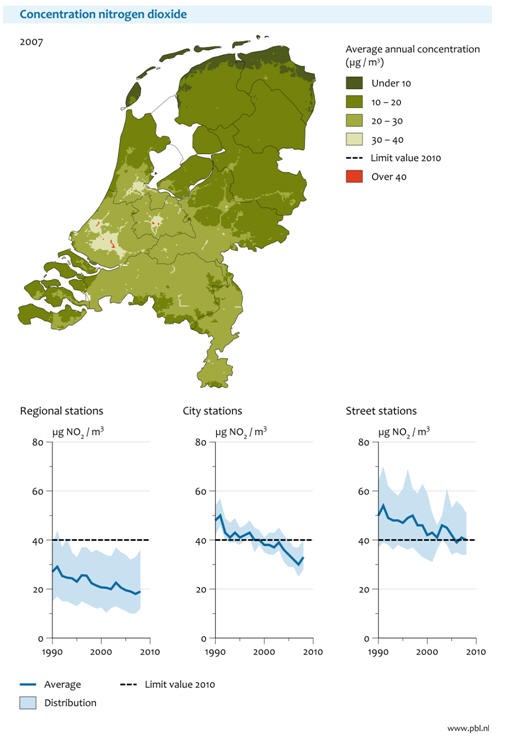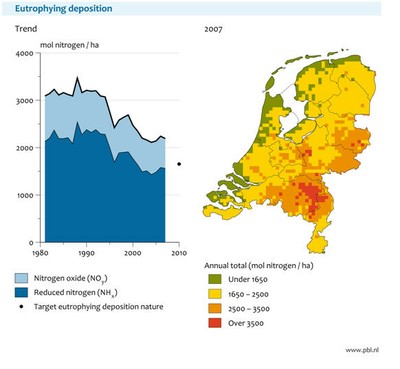Published: 26 Nov 2010
Modified: 11 May 2020
Exceedances of the limit values for NO2
Between
1990 and 2007, NO2 concentrations decreased (Figure 1). In 2008, the
limit value for hourly average concentrations of NO2 was complied
with throughout the country. In the same year, the limit value for yearly
average concentrations of NO2 was likely exceeded along between 300 and
1000 km of roads. About 1 % of the Dutch population was exposed to
concentrations in exceedance of the limit value for yearly average
concentrations of NO2.

Figure 1: NO2
concentrations in the Netherlands
in 2007 (top) and measured trends since 1990 (bottom). Source: http://www.milieuennatuurcompendium.nl/indicatoren/nl0231-Stikstofdioxideconcentratie.html?i=14-66
Exceedances of the limit values for PM10
In 2008, the
limit value for yearly average concentrations of PM10 was complied with
throughout the country, except in the direct vicinity of large point sources such
as harbours with storage and handling of dry bulk goods (Figure 2). The limit
value for daily average concentrations of PM10 was likely exceeded along between
50 and 100 km of roads. Exceedances also occur in the direct vicinity of
stables in intensive agriculture and in the vicinity of harbours. In 2008,
about 0.1 % of the Dutch population was exposed to concentrations in
exceedance of the limit value for daily average concentrations of PM10.
 Figure 2: Number of days in 2008 with PM10 levels above 50 g/m3 (top) and measured trends since 1990 (bottom).
Figure 2: Number of days in 2008 with PM10 levels above 50 g/m3 (top) and measured trends since 1990 (bottom).
Figure 2: Number of days in
2008 with PM10 levels above 50 mg/m3 (top) and measured
trends since 1990 (bottom). Source:
http://www.milieuennatuurcompendium.nl/indicatoren/nl0243-Fijnstofconcentratie%2C-daggemiddelde.html?i=14-66
Exceedances of the target and limit values for
PM2.5
Average PM2.5 concentrations in the urban background
were about 16 mg/m3
in 2008. This is below the EU target value of 20 mg/m3 for 2010 for the average urban background concentration.
Concentrations in busy streets were about 18 mg/m3 in 2008. This is below the EU target value of 25 mg/m3 for 2010 that applies anywhere.
Ozone
concentrations are below target value
Ozone concentrations are below the target value for
protection of human health throughout the country. The number of days with
8-hour average concentrations above 120 mg/m3 has decreased substantially in the period 1990-2000 (Figure
3). Since 2000, further improvement is absent.

Figure 3: Number of days per year with an ozone level
above 120 mg/m3.
Source: http://www.milieuennatuurcompendium.nl/indicatoren/nl0238-Ozonconcentraties-en-volksgezondheid.html?i=14-66
Deposition of acidifying and eutrophying
substances, and exposure of vegetation to ozone
The
deposition of acidifying substances has been reduced by about 50 % since
the early 1980s. In 2007, the deposition was about 2920 mole H+/ha (Figure
4). The deposition is still above the national target of 2.300 mole H+/ha
to be met by 2010.
Deposition
of nitrogen has been rather stable during the past five years. In 2007, deposition
was about 2190 mole N/ha. The deposition is still above the national target of
1.650 mole N/ha to be met by 2010.
Since the
mid 1990s, ozone concentrations, expressed as AOT40, have been below the target
value for the protection of vegetation of 18000 (mg/m3) x hour,
averaged over five years. However, the long-term target for 2020 of 6000 (mg/m3) x
hour is being exceeded.



Figure 4: Deposition of eutrophying and
acidifying compounds, and exposure of vegetation to ozone. Source: http://www.milieuennatuurcompendium.nl/indicatoren/nl0189-Vermestende-depositie.html?i=14-66; http://www.milieuennatuurcompendium.nl/indicatoren/nl0184-Verzurende-depositie.html?i=14-66; http://www.milieuennatuurcompendium.nl/indicatoren/nl0240-Ozonconcentraties-en-vegetatie.html?i=14-66
Impacts
Current and future impacts of air pollution
on public health and vegetation are discussed in Section 5 (Outlook).
Document Actions
Share with others